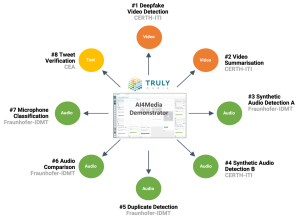Eight new AI services to support future media verification work

As part of their use case in AI4Media, Germany’s international broadcaster Deutsche Welle (DW) and the Athens Technology Centre (ATC) have developed a demonstrator that allows for the testing of new AI services in a media business environment. The services are integrated into a “lab version” of Truly Media, an established platform for collaborative content verification. Here’s an overview of what the services can do:
Video verification services:
- Service #1 analyses the deepfake probability of faces extracted from a video and gives users an overall deepfake probability for the entire clip. Transparent AI information helps users interpret these predictive results (Developer: CERTH-ITI).
- Service #2 is for video summarisation, offering a video synopsis containing all elements deemed relevant, thus helping users save time when dealing with multiple longer videos (Developer: CERTH-ITI).
Audio verification services:
- Service #3 is for synthetic audio detection, alerting users that elements in an audio file might have been generated with Descript voice generation software, also pointing out the level of detection evidence (Developer: Fraunhofer-IDMT).
- Service #4 is another service for synthetic audio detection, aiming to cover a wider range of audio generation software and telling users whether or not synthetic content has been detected (Developer: CERTH-ITI).
- Service #5 is about duplicate detection in audio. It highlights possible duplicates in the audio track, e.g. sections for which a phrase has been copied and pasted (Developer: Fraunhofer-IDMT).
- Service #6 allows users to compare two or more audio files – and to identify matching segments (Developer: Fraunhofer-IDMT).
- Service #7 classifies the microphones used in a recording. It alerts users to possible changes in the recording conditions, e.g. a change in the recording device. (Developer: Fraunhofer-IDMT)
Text verification service:
- Service #8 informs users if the text in a tweet has been generated by AI (more specifically: GPT2) – or written by a human (Developer: CEA).
The use case owners DW and ATC are testing these new services in the context of the existing Truly Media platform and verification workflows but also against business requirements related to AI services in media tools, Trustworthy AI as well as AI compliance. We hope these learnings will have a positive impact on news media verification work – which is getting more complex and demanding by the hour.
Author: Alexander Plaum, Innovation Manager, Deutsche Welle (DW)

